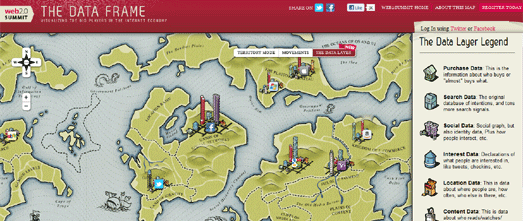The Google Maps of the Internet

The Internet Map is a Google Map of the 350,000 largest websites in the world. The map was created by Ruslan Enikeev and the Russian creative agency Positive Communications.
The circles on the map represent individual websites. The size of the circle is determined by website traffic, the larger the amount of traffic, the bigger the circle. The location of websites on the map is determined by the links between sites. The more traffic generated from links between different websites then the closer the websites are displayed on the map.
It is actually possible to search the map by country to find the most popular websites in individual countries.

The Web 2 Map is a metaphor of the internet, as seen by the organisers of the Web 2.0 Summit. The map assigns territories or 'countries' to different sectors of the internet, for example 'social networks', 'search' 'e-commerce' etc.
The map also includes a data layer. The data layer adds what might be seen as capital cities to the map. The buildings or skyscrapers in the city act as a metaphor for the different data segments within the dominant player in that sector.
For example, the Union of Social Networks includes a Facebook capital city. The Facebook city is dominated by a 'social' skyscraper but also includes a smaller 'location' building to reflect that Facebook also now includes check-ins etc.

TeleGeography's Submarine Cable Map looks at the physical connections that make it possible for the internet's data to travel around the world.
The map depicts 188 active and planned submarine cable systems and their landing stations. Both the cables and their landing points on the map are interactive. Clicking a cable provides access to data about the cable, including the cable’s name, ready-for-service (RFS) date, length, owners, website, and landing points. Clicking a landing point reveals a list of all submarine cables landing at that station.
The map makes great use of Google Map styles and custom info windows to create a map that is both functional and great to look at.


Comments